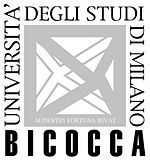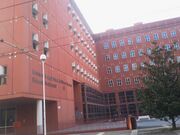University of Milano-Bicocca
Topic: Organization
 From HandWiki - Reading time: 3 min
From HandWiki - Reading time: 3 min
[ ⚑ ] 45°30′52″N 9°12′48″E / 45.51444°N 9.21333°E
Università degli Studi Milano-Bicocca | |
 | |
| Motto | Audentes fortuna iuvat (Fortune favors the bold) |
|---|---|
| Type | State-supported |
| Established | 10 June 1998[1] |
| Rector | Prof. Giovanna Iannantuoni |
| Students | 33,752 (2017/18) |
| Location | Milan and Monza , (Italy) |
| Campus | Urban |
| Sports teams | CUS Milano |
| Website | Unimib.it/ |
The University of Milano-Bicocca (Italian: Università degli Studi di Milano-Bicocca, UNIMIB) is a public university located in Milan, Italy, providing undergraduate, graduate and post-graduate education. Established in 1998, it was ranked by the Times Higher Education 2014 ranking of the best 100 Universities under 50 years old as number 21 worldwide and first in Italy.
Campus
The University of Milano-Bicocca is located in an area on the northern outskirts of Milan, which was occupied by the Pirelli industrial complex until the late 1980s. The industrial area has been redesigned by architect Vittorio Gregotti into an urban complex, including the University of Milano-Bicocca’s research laboratories and student residence halls.[1]
History
The University of Milano-Bicocca has its origins from the splitting of the University of Milan, which with about 90,000 students in the 1990s was becoming overcrowded. A large area in the north of Milan, the Bicocca, was chosen as the location for the new university. This area was occupied by the Pirelli industrial complex until the 1980s and the new campus was part of a larger urban renewal project. The university was officially established on 10 June 1998.
Milan-Bicocca is a multidisciplinary university which offers a wide range of academic programs in different disciplinary fields: Economics, Informatics, Statistics, Law, Education, Sociology, Medicine and Surgery, Maths, Natural Sciences, Physics and Astrophysics, Chemistry, Computer Sciences, Biotechnology and Psychology.
Organization
There are eight faculties at the University of Milan-Bicocca:
- Faculty of Economics and Statistics [2]
- Faculty of Science of education [3]
- Faculty of Law [4]
- Faculty of Mathematics, Physics and Natural Sciences [5]
- Faculty of Medicine [6](which is based in Monza, Lissone e Vedano al Lambro, at the Hospital San Gerardo)
- Faculty of Psychology [7]
- Faculty of Sociology [8]
The number of students at the university has grown steadily since it opened: in its first academic year there were 15,300 students, which had risen to 27,481 in 2003-2004 and by 2005-2006 there were over 30,000.
See also
- ESDP-Network
- List of Italian universities
- Milan
- University of Milan
References
- ↑ 1.0 1.1 "History". Università degli studi di Milano Bicocca. http://www.unimib.it/go/page/English/MENU-HOME/The-Campus/History. Retrieved 20 November 2011.
- ↑ "Scuola di Economia e Statistica". Economia.unimib.it. http://www.economia.unimib.it/. Retrieved 2016-05-11.
- ↑ "Facoltà di Scienze della Formazione". Formazione.unimib.it. http://www.formazione.unimib.it/. Retrieved 2012-07-31.
- ↑ "Facoltà di Giurisprudenza". Giurisprudenza.unimib.it. http://www.giurisprudenza.unimib.it/. Retrieved 2012-07-31.
- ↑ "Facoltà di scienze matematiche, fisiche e naturali". Scienze.unimib.it. http://www.scienze.unimib.it/. Retrieved 2012-07-31.
- ↑ "Facoltà di Medicina e Chirurgia". Medicina.unimib.it. http://www.medicina.unimib.it/cmsMedicina/home.do;jsessionid=001113E9DC7F3F16808F435121B8556C. Retrieved 2012-07-31.
- ↑ "Facoltà di Psicologia; Università di Milano Bicocca". Psicologia.unimib.it. http://www.psicologia.unimib.it/. Retrieved 2012-07-31.
- ↑ "Facoltà di Sociologia". Sociologia.unimib.it. 2012-07-23. http://www.sociologia.unimib.it/. Retrieved 2012-07-31.
External links
- University of Milano-Bicocca Website (in Italian and English)
 KSF
KSF
